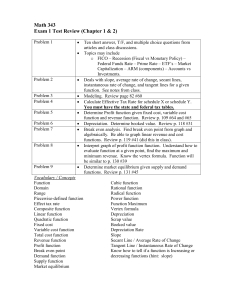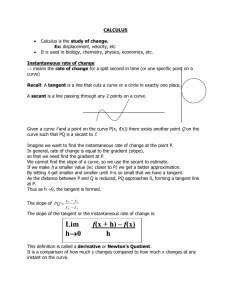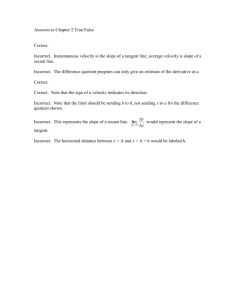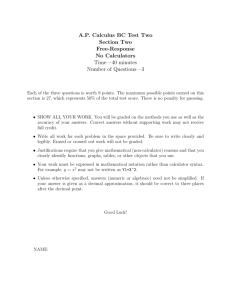Section 2.6 -‐ The Derivative Slope of a Line Applying the Idea
advertisement
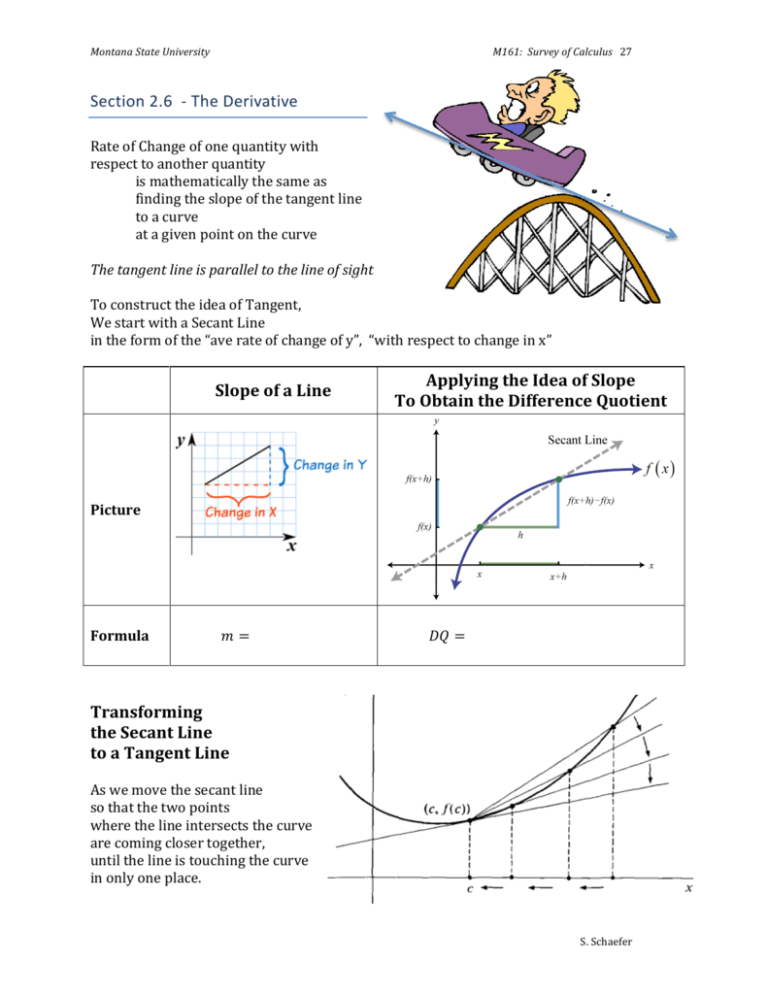
Montana State University M161: Survey of Calculus 27 Section 2.6 -­‐ The Derivative Rate of Change of one quantity with respect to another quantity is mathematically the same as finding the slope of the tangent line to a curve at a given point on the curve The tangent line is parallel to the line of sight To construct the idea of Tangent, We start with a Secant Line in the form of the “ave rate of change of y”, “with respect to change in x” Applying the Idea of Slope To Obtain the Difference Quotient Slope of a Line Picture Formula ! = !" = Transforming the Secant Line to a Tangent Line As we move the secant line so that the two points where the line intersects the curve are coming closer together, until the line is touching the curve in only one place. S. Schaefer Montana State University M161: Survey of Calculus 28 Slope of a Tangent Line Derivative of a Function The slope of a tangent line to the graph of f, At the point p = (x, f(x)) is given by: “instantaneous rate of change” The derivative of a function f(x) with respect to x is the function f’(x), (read f’(x) as f prime) The domain of f’(x) is the set of all x where the limit exists Other Derivative Notation: • Dxf(x) “read as d sub x of x” !" • !" “read as dy dx” • y’ “read as y prime” 4 Step Process for Finding f’(x) Also used for finding the slope of the tangent line to the graph of the given function at ANY point 4 Step Process Example f(x) = 3x + 5 Step 1: Step 1: Step 2: Step 2: Step 3: Step 3: Step 4: Step 4: If you are asked to use the limit definition to find the derivative, this is the process you MUST use! S. Schaefer Montana State University M161: Survey of Calculus 29 Examples Use the 4-­‐Step process to find the slope of the tangent line to the graph of the given function. Example ! ! = ! ! !"#$ 1: ! ! + ℎ = !"#$ 2: ! ! + ℎ − !(!) = !"#$ 3: ! ! + ℎ − !(!) = ℎ ! ! + ℎ − !(!) = !→! ℎ !"#$ 4: ! ! ! = lim !"#$%&' ! ! 2 = !"#$: ! ! 2 !" !ℎ! !"#$% !" !ℎ! !"#$!"# !"#$ !" !ℎ! !"#$ℎ !" ! ! = ! ! !" !ℎ! !"#$% (2, 4) Example ! ! = ! ! − 4! !"#$ 1: ! ! + ℎ = !"#$ 2: ! ! + ℎ − !(!) = !"#$ 3: ! ! + ℎ − !(!) = ℎ ! ! + ℎ − !(!) = !→! ℎ !"#$ 4: ! ! ! = lim NOW, find the point on the graph of f(x) where the tangent to the curve is horizontal. Hint: What is the slope of a horizontal line? ______ S. Schaefer Montana State University M161: Survey of Calculus 30 Finding the Equation of the Tangent Line Recall: The derivative, f’(x), is the _______________ of the tangent line. To find the equation of the tangent line, we will need (1) a point and (2) a slope. Then we can use point-­‐slope form: ! − !! = !(! − !! ) Equation of the Tangent Line Must know how to do! !"#$% !"# !" ! = !! !!"#$ !"# !" (!! , !! ) STEP 1: STEP 1: STEP 2: STEP 3: Examples Find the slope of the tangent line to the graph of each function at the given point and determine an equation of the tangent line. 1) ! ! = 3! − ! ! !" !ℎ! !!"#$ (−2, −10) S. Schaefer Montana State University 2) ! ! = M161: Survey of Calculus 31 1 !" !ℎ! !"#$% ! = 2 ! Differentiability and Continuity These two statements go together. They are logically equivalent! If a function is differentiable at x=a, then: If a function is not continuous at x=a, then: This statement is by itself, and it does NOT help us at all! Maybe the derivative exists. Maybe it doesn’t. If a function is continuous at x=a, then WE KNOW NOTHING about the derivative! Places where a function can fail to be differentiable: S. Schaefer




